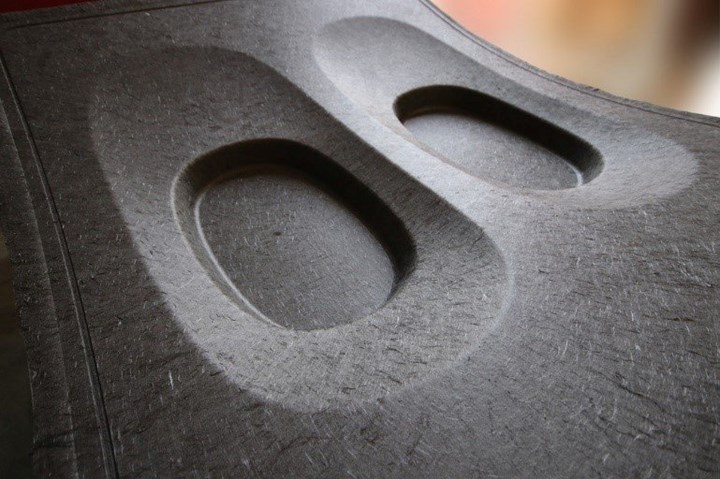Cannon Ergos collaborates with Boeing to mold thermoplastic aircraft sidewall panels
Mold trials study the feasibility of using recycled carbon fiber, whether impregnated with diverse resins, or already integrated within a thermoplastic matrix.
Share

RCF-reinforced thermoplastic sidewall prototype. Photo Credit: Cannon Ergo
Cannon Group company, Cannon Ergos (Caronno Pertusella, Italy), a technologies, processing equipment and mold manufacturer for the composites industry, is working with Boeing (Chicago, Ill., U.S.) on molding trials for the feasibility of using recycled carbon fiber (rCF) for the fabrication of aircraft cabin interior sidewall panels.
The recovery and reuse of carbon fiber waste during production processes and end-of-life (EOL) applications, such as automotive and aeronautics, has proved to be economically viable, the company notes. This supports the implementation of the EU Waste Framework Directive (2008/98/EC) to greatly reduce landfill disposal which is environmentally essential and is also in line with targets set by the EU Circular Economy Package for sustainable production practices.
“For several years, together with sister companies Cannon Afros and Cannon Tipos, we have successfully undertaken numerous projects that offer new life to rCF,” Mattia Andolfatto, project manager R&D at Cannon Ergos, says. “By combining various technologies and production processes tailored for each application, we have been able to effectively process rCF whether impregnated with diverse resins, or already integrated within a thermoplastic matrix. The project with Boeing demonstrates the viability of fabricating interior sidewall panels with high-performance thermoplastics reinforced with recycled carbon fiber.”
The project’s latest stage involves Mitsubishi Chemical Advanced Materials (MCAM, Lenzburg, Switzerland), a global supplier of high-performance reinforced polymers for which Cannon Ergos has designed, manufactured and installed a customized and fully equipped thermo-compression unit. This equipment was used to produce prototype sidewall panels with the new Kyrontex material. Typical resin matrices used for Kyrontex thermoplastic composite aeronautical applications include polyamide (PA), polyetherimide (PEI), polyphenylene sulfide (PPS), polyetheretherketone (PEEK) and polyaryletherketone (PAEK).
Related Content
-
Welding is not bonding
Discussion of the issues in our understanding of thermoplastic composite welded structures and certification of the latest materials and welding technologies for future airframes.
-
Cryo-compressed hydrogen, the best solution for storage and refueling stations?
Cryomotive’s CRYOGAS solution claims the highest storage density, lowest refueling cost and widest operating range without H2 losses while using one-fifth the carbon fiber required in compressed gas tanks.
-
Infinite Composites: Type V tanks for space, hydrogen, automotive and more
After a decade of proving its linerless, weight-saving composite tanks with NASA and more than 30 aerospace companies, this CryoSphere pioneer is scaling for growth in commercial space and sustainable transportation on Earth.













